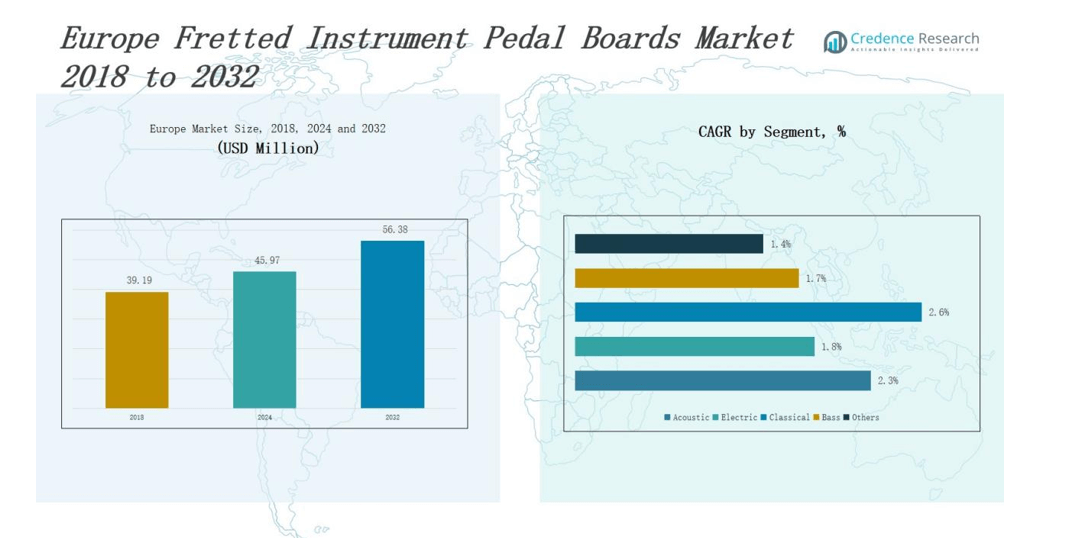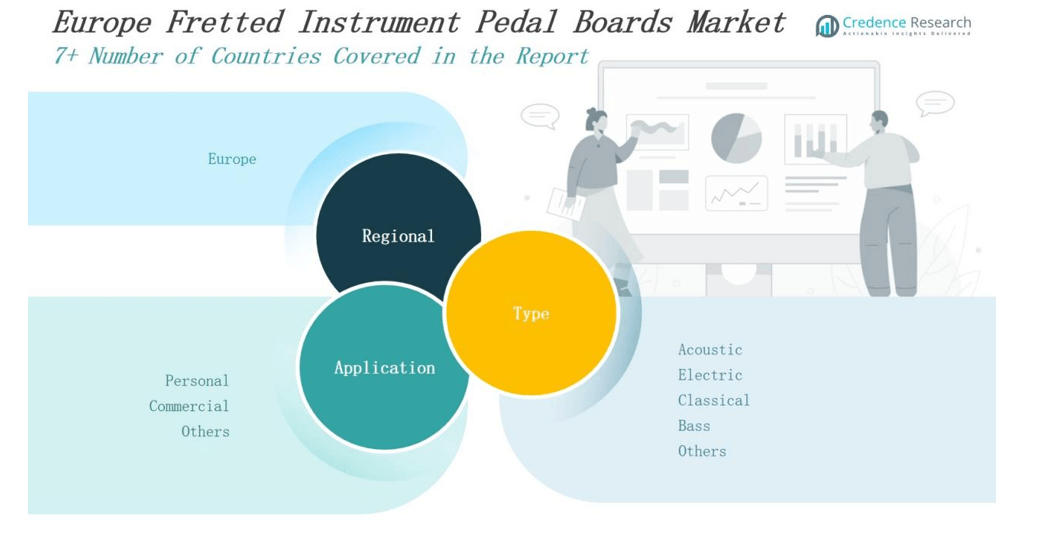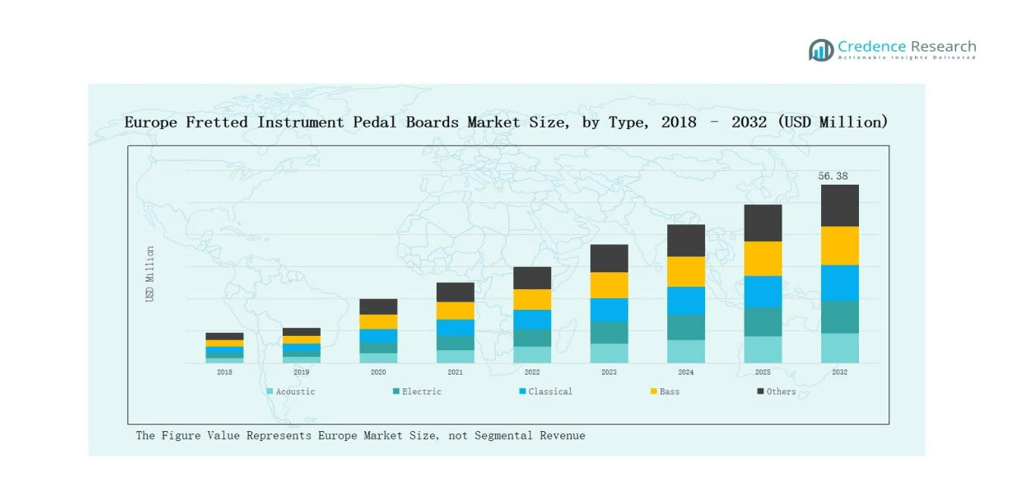Market Overview
Europe Fretted Instrument Pedal Boards Market size was valued at USD 39.19 million in 2018 to USD 45.97 million in 2024 and is anticipated to reach USD 56.38 million by 2032, at a CAGR of 2.3% during the forecast period.
| REPORT ATTRIBUTE |
DETAILS |
| Historical Period |
2020-2023 |
| Base Year |
2024 |
| Forecast Period |
2025-2032 |
| Europe Fretted Instrument Pedal Boards Market Size 2024 |
USD 45.97 million |
| Europe Fretted Instrument Pedal Boards Market, CAGR |
2.3% |
| Europe Fretted Instrument Pedal Boards Market Size 2032 |
USD 56.38 million |
The Europe Fretted Instrument Pedal Boards Market is characterized by the presence of prominent players such as Ritter Bags, Fusion Bags, Stagg, Gruv Gear, Yamaha, Dunlop, Harley Benton, Behringer, Temple Audio, and Gator, all of which maintain strong competitive positions through innovative product designs, quality materials, and brand recognition. These companies cater to both professional and amateur musicians, offering a diverse range of pedal board solutions to meet varying performance and portability needs. Within Europe, Germany leads the market, accounting for 28.6% of the regional share, driven by its robust music industry, high consumer spending on musical equipment, and strong distribution networks.

Market Insights
- The Europe Fretted Instrument Pedal Boards Market grew from USD 39.19 million in 2018 to USD 45.97 million in 2024 and is expected to reach USD 56.38 million by 2032, driven by steady demand from both professional and amateur musicians.
- Germany leads the market with 28.6% share, supported by a robust music industry, high consumer spending on musical equipment, and strong distribution networks, followed by the UK and France as key markets.
- Expanding live music events, rising home studio adoption, and continuous product innovations such as modular layouts and integrated power supplies are driving adoption across diverse user groups.
- The market faces challenges from intense competition, price sensitivity in emerging regions, and raw material cost fluctuations, prompting manufacturers to balance affordability with quality and durability.
- E-commerce expansion, customization trends, and targeted marketing in underpenetrated markets present growth opportunities for established brands and new entrants across Europe.
Access crucial information at unmatched prices!
Request your sample report today & start making informed decisions powered by Credence Research Inc.!
Download Sample
Market Segment Insights
By Type
In the Europe Fretted Instrument Pedal Boards Market, the electric segment holds the dominant position, driven by the extensive use of electric guitars and basses in live performances, studio recordings, and personal setups. Demand is supported by the popularity of rock, pop, and contemporary music genres across the region, alongside the need for organized and easily transportable pedal arrangements. Innovations such as modular board systems, integrated power solutions, and lightweight yet durable materials have further strengthened adoption among both professional musicians and hobbyists.
- For instance, Aclam Guitars, developed a patented Smart Track® system that secures pedals without adhesives, preserving pedal condition while allowing quick reconfiguration.
By Application
The personal segment leads the market, supported by a rising number of hobbyists, independent artists, and semi-professional players seeking reliable and customizable pedal board solutions. Growth is fueled by the expansion of home recording setups, increased participation in online music content creation, and greater accessibility through e-commerce platforms. Users prioritize portability, flexibility, and affordability, making this segment a key driver of overall market demand across Europe.
- For instance, Boss launched the MS-3 Multi Effects Switcher in Europe, highlighting its portable design and flexible configuration aimed at home recording enthusiasts and gigging musicians.
Market Overview
Expanding Live Music and Event Industry
The growth of live music venues, festivals, and performance events across Europe is a major catalyst for the fretted instrument pedal boards market. Musicians increasingly seek portable and customizable pedal boards to optimize stage setups and ensure consistent sound quality. Countries such as Germany, the UK, and France host numerous music festivals annually, creating strong demand for durable, performance-ready products. Rising participation from both professional and amateur artists, coupled with greater access to international touring opportunities, has reinforced this demand and encouraged continuous innovation in pedal board designs.
- For instance, Schmidt Array from Germany offers custom pedalboards designed for ergonomic functionality and seamless connectivity, catering to professional musicians who require adaptable setups for diverse live performances.
Rising Popularity of Home Studios and Online Music Production
The surge in home-based music recording and content creation has significantly boosted the need for pedal boards. Musicians, influencers, and hobbyists are investing in compact, efficient, and visually appealing pedal board solutions for use in personal studios. The rise of streaming platforms and social media channels, such as YouTube and Instagram, has amplified the importance of high-quality sound processing. This shift has driven manufacturers to develop versatile, user-friendly boards that cater to both studio recording and live streaming environments, supporting growth beyond traditional performance settings.
- For instance, the Aclam Smart Track S2 offers a modular and adhesive-free pedal attachment system ideal for versatile home or live setups, reflecting the trend towards flexible, user-friendly pedal boards for streaming and recording.
Technological Advancements and Product Innovation
Continuous advancements in pedal board designs, materials, and integration features are enhancing their appeal among European musicians. Lightweight yet durable materials, modular layouts, integrated power supplies, and cable management systems have improved portability and ease of use. Brands are also introducing hybrid pedal boards compatible with both analog and digital effects, appealing to a wider audience. These innovations not only improve performance efficiency but also align with evolving consumer preferences for customization, ultimately driving adoption across various music genres and skill levels.

Key Trends & Opportunities
Shift Toward Customizable and Modular Designs
A growing number of European musicians prefer pedal boards that can be customized to match their unique performance styles and equipment needs. Modular designs allow users to expand or rearrange setups easily, appealing to both touring professionals and home-based players. This trend has encouraged manufacturers to offer adjustable layouts, interchangeable panels, and integrated connectivity features, creating opportunities for premium product segments. The demand for personalization is expected to further expand as musicians seek greater creative control over their sound configurations.
- For instance, Joe Satriani’s rig features custom true bypass switch technology and signature pedals like Vox Big Bad Wah and Vox Time Machine delays, arranged in a modular fashion to facilitate quick changes and tonal flexibility for his solo and band projects.
Expansion of E-commerce and Direct-to-Consumer Sales
The rapid growth of online retail platforms has transformed the distribution landscape for pedal boards in Europe. E-commerce provides consumers with wider product selection, competitive pricing, and access to global brands without geographical limitations. Direct-to-consumer strategies enable manufacturers to strengthen brand loyalty by offering exclusive designs, bundles, and after-sales support. This channel expansion presents significant opportunities for both established players and emerging brands to reach niche markets, particularly in regions where physical music retail infrastructure is limited.
- For instance, Rhuitsept, a French workshop, specializes in custom-made pedal boards, handling everything from design to cabling and manufacturing locally in Europe, offering personalized direct-to-consumer service within the region.
Key Challenges
High Competition and Price Sensitivity
The Europe fretted instrument pedal boards market faces intense competition from both established global brands and low-cost regional manufacturers. Price-sensitive consumers, particularly in emerging Eastern European markets, often prioritize affordability over premium features, creating pressure on profit margins. To remain competitive, companies must balance quality with cost-efficiency while differentiating through design, brand reputation, or value-added services.
Fluctuations in Raw Material Costs
Variations in the cost of raw materials such as aluminum, plastics, and composites can impact manufacturing expenses and product pricing. These fluctuations, often driven by global supply chain disruptions or economic instability, can affect profitability for manufacturers. Companies must adopt flexible sourcing strategies and explore alternative materials to mitigate risks while maintaining product quality and durability standards.
Limited Awareness in Niche Consumer Segments
While professional musicians are well-versed in the benefits of pedal boards, awareness remains limited among beginner and casual players. This knowledge gap can slow adoption rates in certain consumer segments, especially in regions with smaller live music cultures. Effective marketing, education initiatives, and entry-level product lines are necessary to expand market reach and cultivate long-term brand loyalty in these underpenetrated areas.
Regional Analysis
Germany
Germany holds the leading position in the Europe fretted instrument pedal boards market with a market share of 29%. It benefits from a strong music industry, a large base of professional musicians, and a well-developed live performance sector. The country’s vibrant festival scene and high demand for premium musical equipment sustain steady sales. Manufacturers and distributors leverage Germany’s advanced retail infrastructure to reach both domestic and international customers. The presence of well-established brands and active adoption of innovative pedal board designs further support growth. It remains a key hub for product launches and industry collaborations within Europe.
United Kingdom
The United Kingdom accounts for 21% of the regional market share, driven by its active music culture and significant number of live events. Demand is reinforced by the popularity of genres that heavily rely on electric guitars and effects pedals. The country’s concentration of recording studios and touring musicians supports consistent purchases of high-quality pedal boards. Local and international brands benefit from the UK’s strong online retail penetration. Consumer preference for customizable and portable solutions aligns with ongoing product innovations. It continues to represent a vital market for premium and mid-range pedal board segments.
France
France holds a 14% share of the regional market, supported by its growing base of professional and semi-professional musicians. The country’s music festivals and cultural events generate a steady need for performance-ready gear. Rising interest in home music production has created new demand channels beyond traditional retail outlets. French consumers show a balanced preference for both premium and affordable pedal board options. Manufacturers target the market with designs that combine style, durability, and functionality. It remains a promising segment due to evolving musical preferences and rising participation in live performances.
Italy
Italy represents 12% of the market share, driven by a blend of traditional and contemporary music scenes. Demand is fueled by an increasing number of independent artists and bands. Local distributors play a significant role in making global brands accessible across the country. Italian musicians value aesthetic appeal alongside performance efficiency in pedal board design. Growth opportunities exist in both personal and commercial application segments. It continues to attract attention from manufacturers seeking to expand in Southern Europe.
Spain
Spain accounts for 10% of the regional market share, supported by an expanding live performance sector. The growth of music tourism and local cultural festivals has increased equipment purchases. The market benefits from a rising number of hobbyist musicians investing in home setups. E-commerce platforms strengthen accessibility to diverse product ranges. Brands focus on lightweight and budget-friendly designs to appeal to wider audiences. It remains a dynamic market with opportunities for both local and international suppliers.
Russia
Russia holds an 8% share of the Europe market, with demand concentrated in urban centers with active music communities. Challenges include logistics and import regulations, yet interest in premium equipment is growing among professional musicians. Local music schools and performance venues contribute to stable demand. Brands with strong distribution partnerships maintain a competitive edge. Consumer interest in durable, road-ready pedal boards is increasing. It offers growth potential through targeted marketing and regional dealer networks.
Rest of Europe
The Rest of Europe segment captures 6% of the market share, covering smaller but emerging music markets. Countries in this category are experiencing gradual growth in live performances and independent music production. Limited retail infrastructure in some areas drives reliance on online purchasing. Manufacturers see potential in entry-level and mid-range products for these markets. Cultural diversity supports varied design and feature preferences. It presents opportunities for brands willing to invest in market education and local partnerships.


Market Segmentations:
By Type
- Acoustic
- Electric
- Classical
- Bass
- Others
By Application
- Personal
- Commercial
- Others
By Region
- Germany
- UK
- France
- Italy
- Spain
- Russia
- Rest of Europe
Competitive Landscape
The competitive landscape of the Europe Fretted Instrument Pedal Boards Market is defined by a mix of established global brands and specialized regional manufacturers competing on product quality, innovation, and distribution reach. Key players such as Ritter Bags, Fusion Bags, Stagg, Gruv Gear, Yamaha, Dunlop, Harley Benton, Behringer, Temple Audio, and Gator dominate through extensive product portfolios catering to both professional musicians and hobbyists. Companies focus on developing lightweight, durable, and customizable pedal boards with integrated power solutions to meet evolving user demands. Strategic partnerships with retailers, expansion into e-commerce, and participation in major music trade shows strengthen market presence. Brand loyalty is reinforced by consistent quality, strong after-sales support, and endorsements from professional artists. Competitive pressure encourages continuous design improvements and targeted marketing, enabling manufacturers to capture diverse customer segments across high-value markets such as Germany, the UK, and France, while also expanding into emerging European regions.
Shape Your Report to Specific Countries or Regions & Enjoy 30% Off!
Key Players
Recent Developments
- In January 2025, Dunlop introduced multiple additions at Winter NAMM, including the MXR Rockman X100 Analog Tone Processor and the Mick Ronson Cry Baby Wah, showcasing its ongoing commitment to innovation in effects equipment.
- In June 2023, Harley Benton revealed its Spaceship pedalboards with integrated PowerBar power supplies and rechargeable batteries, emphasizing enhanced portability and energy efficiency for musicians.
- In December 2024, Behringer marked its return to NAMM 2025 with a strong focus on FX pedals, unveiling two new models and reinforcing its competitive presence in the market.
- In June 2023, The British Pedal Company released the “King of Fuzz Tone Bender MKII,” a digitally advanced fuzz pedal that blends authentic vintage tones with modern build quality.
Market Concentration & Characteristics
The Europe Fretted Instrument Pedal Boards Market demonstrates a moderately concentrated structure, with a few leading brands holding significant market influence while numerous smaller manufacturers compete in niche segments. It is characterized by strong brand recognition, high product differentiation, and continuous innovation in design, materials, and functionality. Established players maintain competitive advantages through extensive distribution networks, strategic partnerships, and endorsements from professional musicians. The market caters to a diverse customer base, ranging from touring professionals to hobbyist musicians, with demand driven by both live performance and home studio applications. It exhibits steady growth potential supported by rising music culture, expanding e-commerce penetration, and increasing customization trends. Competitive dynamics encourage manufacturers to balance quality and cost-effectiveness while adapting to regional preferences. The presence of both premium and budget-friendly product lines ensures accessibility, fostering a balanced competitive environment that supports innovation and market expansion across Europe.
Report Coverage
The research report offers an in-depth analysis based on Type, Application and Region. It details leading market players, providing an overview of their business, product offerings, investments, revenue streams, and key applications. Additionally, the report includes insights into the competitive environment, SWOT analysis, current market trends, as well as the primary drivers and constraints. Furthermore, it discusses various factors that have driven market expansion in recent years. The report also explores market dynamics, regulatory scenarios, and technological advancements that are shaping the industry. It assesses the impact of external factors and global economic changes on market growth. Lastly, it provides strategic recommendations for new entrants and established companies to navigate the complexities of the market.
Future Outlook
- Demand for customizable and modular pedal board designs will increase as musicians seek greater flexibility in their setups.
- Adoption of lightweight and durable materials will rise to enhance portability without compromising strength.
- Online sales channels will continue to gain market share, expanding access to a wider customer base across Europe.
- Integration of built-in power supplies and cable management systems will become a standard feature in premium models.
- Growth in home studio setups will drive sales among hobbyists and independent musicians.
- Manufacturers will expand their presence in emerging European markets through targeted distribution strategies.
- Collaborations with professional artists will strengthen brand visibility and consumer trust.
- Sustainability-focused product development will gain traction as eco-conscious consumers influence buying preferences.
- Technological enhancements in digital and hybrid pedal board solutions will attract a broader user segment.
- Competition will intensify, prompting continuous innovation and differentiation in product design.










